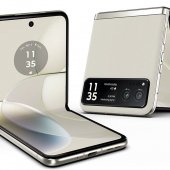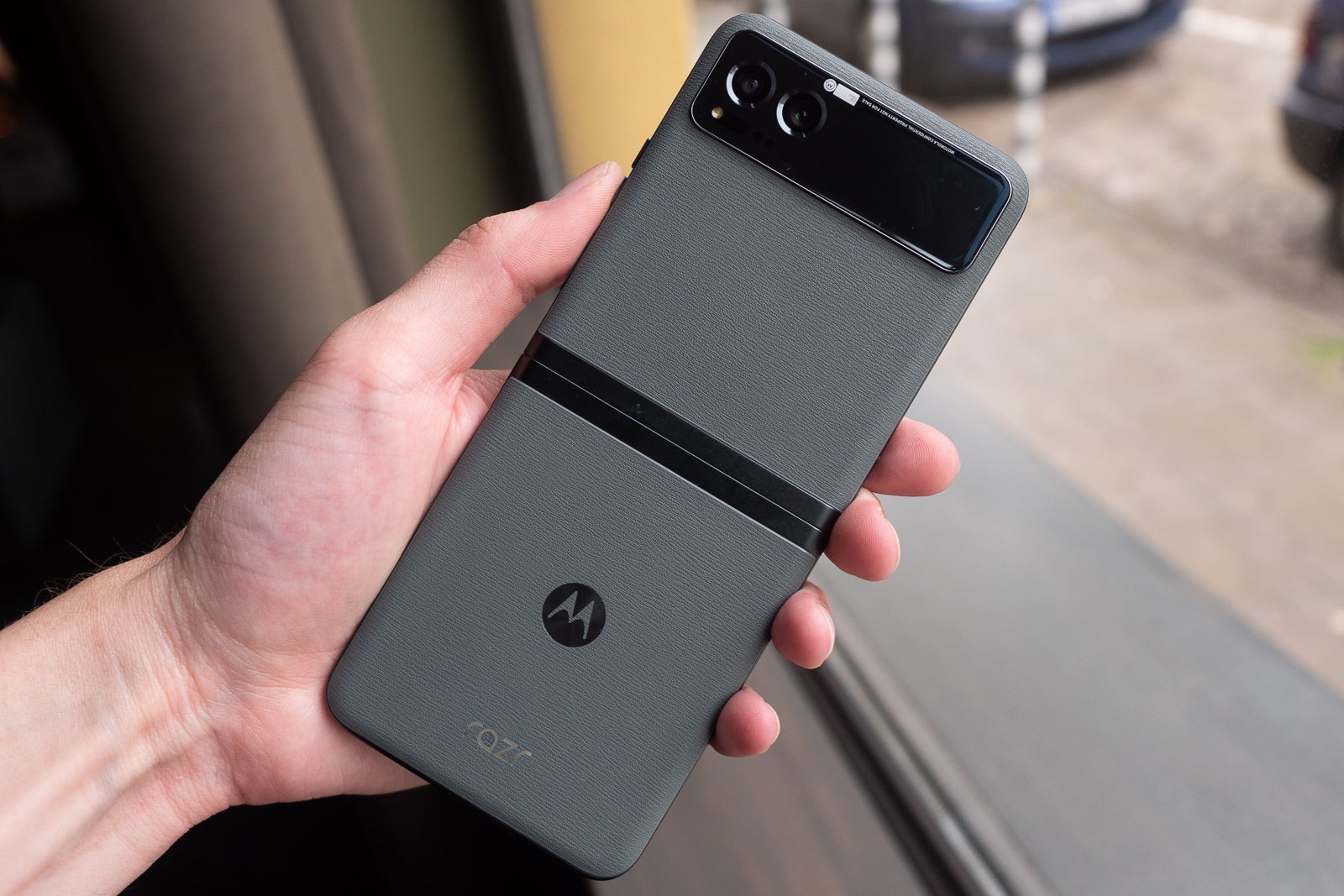Hot Models:
Samsung Galaxy Note 4
:
Apple iPhone 6
:
Samsung Galaxy Note Edge
:
Samsung Gear S
:
Motorola Moto G
:
Samsung Galaxy S5
29 Jul 2023

The Motorola Razr 40 is a less powerful version of the Razr 40 Ultra that aims to reclaim Razr as a phone for the general public. Although it is no longer a flip-up phone but rather a foldable one, using it retains the same coolness as the V3 nearly 20 years ago.
The Razr 40 makes using a foldable phone easier than ever, but it still feels like a phone that is perfectly balanced. It has the same large internal display and clean software as the Razr 40 Ultra, as well as a larger battery and larger main camera sensor. It lacks a large external display and has a Snapdragon 7 Gen 1 chipset that is in the middle of the market, but it manages to cut over €200 off its asking price.
Similar in size and weight as the Ultra, the Razr 40's shell is made of vegan leather rather than glass. Even while its exterior display, at just 1.5 inches, is substantially smaller, it can still be used as a camera viewfinder and for quick notification checks.
Motorola Razr 40
 After that, you'll see the same foldable 6.9-inch LTPO AMOLED as the Ultra, with HDR10+ support, an extended 1080p resolution, 1B colors, and a refresh rate of up to 144 Hz. The Ultra had a maximum refresh rate of up to 165 Hz, but we barely saw the phone use that.
After that, you'll see the same foldable 6.9-inch LTPO AMOLED as the Ultra, with HDR10+ support, an extended 1080p resolution, 1B colors, and a refresh rate of up to 144 Hz. The Ultra had a maximum refresh rate of up to 165 Hz, but we barely saw the phone use that.
The Snapdragon 7 Gen 1 SoC has replaced the flagship 8+ Gen 1 chip found inside the Ultra, and is the most noticeable difference. And I expect that the target market for the Razr will value the improved battery life that should result from this change more than the diminished performance.
Moving on to cameras, we can see that the Razr 40's primary 64MP sensor is really noticeably larger than the Ultra's 12MP imager. The 32MP selfie camera built into the foldable screen and the 13MP ultrawide camera with AF and macro are identical.
The cameras lack the ability to capture HDR10 video and 4K@60fps footage.

Continuing on toward the battery - the Razr 40 has a 4,200mAh cell, up from 3,800mAh on the Ultra. However, the two Motorola foldable phones share the same charging speeds of 30W for wired use and 5W for wireless use.
With a few Motorola tweaks and apps, the Razr 40 runs clean Android 13, which many people have come to love over time.
Officially, the Motorola Razr 40 is not a waterproof smartphone. It has an internal coating that repels water, so it will probably withstand a few drops of rain or a splash, but it shouldn't get properly wet.
Unboxing the Motorola Razr 40
A typical paper box is used to package the Razr 40. A 30W power converter, a USB-A to USB-C cable, a SIM ejector, and some papers are all contained within.

A two-piece, semi-transparent hard case for the Razr in the same lilac as the phone can be found above the phone in a paper compartment that is almost invisible.
The provided case fits well on the telephone and looks great. Anyway it obstructed the USB link and we needed to frequently tinker with that one to accomplish great association.
Design, build quality, handling
The Motorola Razr 40 is a typical modern flip phone with two rear panels made of vegan leather (not fancy plastic), an aluminum frame, and a stainless-steel teardrop hinge in the middle. The large internal foldable display is protected by a thin plastic film.

This Razr 40 measures and gauges equivalent to the Razr 40 Ultra, takes on a similar pivot and plan, and has a lot of outside likenesses - regardless of whether the altogether different outer presentation might make you miss them. Even though there were glass and vegan leather versions of the Ultra, we preferred the leather design. Even though everyone will have a different opinion regarding which one looks better, everyone will appreciate the smudge resistance. It simply provides better grip.

The vegan leather's premium appearance is enhanced by the engraving of the Motorola logo and the Razr logo. We still prefer the smooth transition from the cameras to the external display on the standard Razr 40, despite the fact that the 40 Ultra's edge-to-edge display is still way cooler. What's more, the glass is sticking out so minimal that it doesn't make the telephone wobble or shaky (not that it will at any point be perched on this side).
Not exclusively is the general plan perfect, however the Razr 40 form is basically exceptional - from the choice of materials to the exact execution - it empowers superb hold, feel and taking care of. The basic ingress protection, IP52, was the only thing we didn't like.
Now, let's take a look at the Razr 40 and its most interesting features.
The true focal point of the Razr is its foldable 6.9-inch AMOLED display, which is as stunning as it appears in promotional materials. The presentation goes edge to outline with an under 1mm bezel, with adjusted corners and one small poke hole for the selfie camera.

While the display has a crease in the middle, it is hardly perceptible and cannot be seen when fully unfurled. In fact, we had to actively look for it, thus Motorola did a terrific job in this area.
The relatively soft foldable panel will nevertheless have a small plastic bezel around the screen and a plastic screen protector to prevent scratches. On the phone's packaging, Motorola has prominently warned consumers not to remove the screen protector themselves.
Between the screen's plastic bezel and aluminum frame is where the earpiece is located. Its outlet is tilted at around a 45-degree angle, which provides excellent earphone and loudspeaker performance. In fact, the Razr 40 sports a stereo sound system with the main speaker located at the bottom of the phone and the (quieter) one located in the earpiece.
The main microphone and USB-C port are located next to the speaker and are encircled by faintly legible branding and numbers.
Displays
The large foldable 6.9-inch LTPO AMOLED screen that features HDR10+ support, 10-bit color depth, an adaptive refresh rate of 144Hz, touch response of up to 360Hz, and more are at the heart of the Motorola Razr 40. This appears to be the same panel as the Razr 40 Ultra, but the refresh rate has been decreased to 165 Hz.
The foldable screen has a higher resolution of 1080p (1,080 x 2,640 pixels) and a higher density of 413 ppi. It has a tiny punch hole for the selfie camera and a plastic screen protector that you shouldn't peel off to keep the screen working properly.

Compared to the 40 Ultra, the outer display is much smaller and is a 1.5-inch AMOLED panel with 194 x 368 pixels (268 ppi) and a piece of Gorilla Glass Victus. As you can imagine, this screen does not provide the full Android experience as the Ultra does; rather, it only shows a few widgets and can also serve as a camera viewfinder.

The external display is too small to conduct our display tests, and its quality is not particularly important to the Razr 40's operation. Therefore, we immediately move on to the massive foldable panel.
When manually adjusting the brightness using the slider, we measured a maximum of 505 nits of brightness at point white. However, when confronted with a bright light source, the screen's Auto mode setting can go much higher, reaching 1064 nits. These correspond to the measurements we obtained from the Razr 40 Ultra screen.
At point white, the lowest brightness was just 2.9 nits.
Providing cell phone price review in Dubai - United Arab Emirates.
iPhone, Samsung Galaxy, HTC, Nokia, Windows phone price in Dubai with mobile phone review and specification.
Privacy Policy | Terms | Contact US
© 2025 fonfe.com All rights reserved.
iPhone, Samsung Galaxy, HTC, Nokia, Windows phone price in Dubai with mobile phone review and specification.
Privacy Policy | Terms | Contact US
© 2025 fonfe.com All rights reserved.









